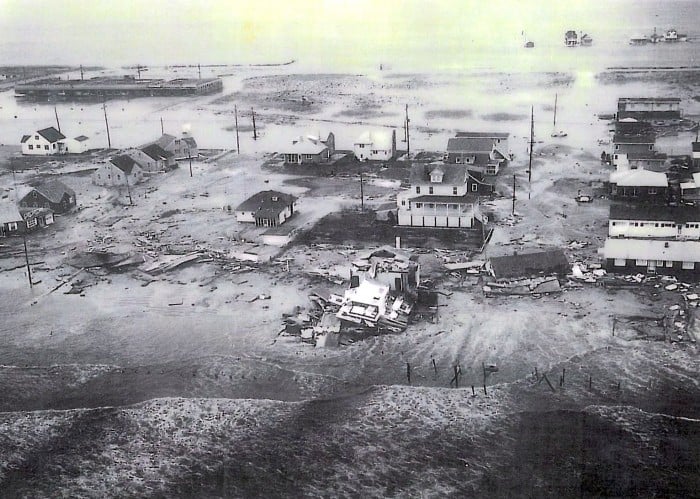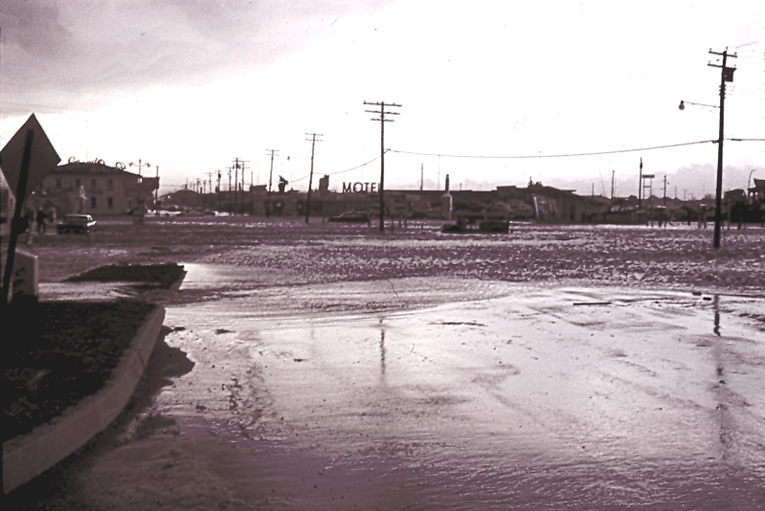It looks like my underwater Wildwood condo could be really underwater in the next few days. This storm is projected to make a direct hit on Wildwood. The last time a storm of this magnitude hit Wildwood was in 1962, exactly 50 years ago. It looks like we are going to have a helluva 50 year anniversary party. This storm is bigger than the 1962 storm. It is going to hit during a full moon. It is predicted to last for 36 hours. Wildwood is an island. When it rains heavily, the streets flood because the storm drains leading to the ocean cannot drain fast enough. In 1962 West Wildwood was virtually wiped off the map, as the back bay met the ocean. Here are a few pictures of the devastation:










Explaining The Shore Impact From Sandy
Sandy doesn’t have that same ‘tropical’ look that it had yesterday. Don’t be fooled by the look though. An approaching cool front and mid atmospheric trough will infuse additional energy into the storm over the coming days, with the result being a strong storm that will impact much of the East Coast.
Another post around midday from Kevin Wagner will outline the wind, rain, water impacts for the region. Track does matter to a point but since the system will be evolving away from a purely tropical storm into a nontropical entity there are some things that this storm will have that will not be in your “usual” tropical system. The wind field will be larger geographically — and not necessarily stronger to the north of the storm either. Some wind gusts in the southwest quadrant of the storm may be stronger due to baroclinic influence. Whether the storm comes ashore in New Jersey or Maryland does not matter in the grand scheme of things for someone in Pottstown or Philadelphia — it will be windy for inland regions.
At the Shore, track does matter more. Modeling does suggest a window from the Delmava to Long Island, with the very, very consistent European computer model continuing to suggest that Sandy’s low pressure center comes ashore over the Delmarva.
In terms of coastal impacts, the Euro landfall is arguably the worst case scenario for Delaware and South Jersey coastlines. The combination of east winds and monthly high tides that will occur on Monday will cause rather nasty coastal flooding for Jersey and Delaware coastlines and the interior side of the back bays. Given the size of the storm, impacts will still be noticeable up the coast into New York City and Long Island as winds will be from the east, gusty, and pushing water onshore. Coastal flooding impacts will be widespread over a larger swath of real estate. East winds that could gust to hurricane force will do a number of the beaches and on Shore properties if the Euro’s scenario plays out.
If a landfall farther up the coast takes place…and this is an unlikely scenario, the impacts are different. If the center comes ashore over Long Island (as an example), the strongest winds and onshore flow will be over the Hamptons and Southern New England while an offshore wind is pushing water out into the Atlantic over New Jersey and Delaware. There would be some flooding from the back bays along the barrier islands in New Jersey once the storm center moved east of your location. However, in terms of coastal flooding and beach erosion the impacts would not be as bad in this scenario since the storm would move onshore to our north. Still bad since we would have to go through Sunday night and Monday with an east wind…just not as bad since the storm would track a little bit farther out to sea. Odds don’t favor this scenario (at least as far as a Long Island landfall) playing out though. However, it’s important to point out that with Sandy, despite its large size, the location where the storm comes ashore will matter for coastal residents in terms of how long the east winds last and how much coastal flooding takes place.
One of the differences between this storm and Irene is that Irene was faster moving whereas Sandy will be moving at nearly half of Irene’s forward momentum (ten miles per hour or so versus Irene which moved at nearly twenty) as it comes ashore. Irene’s worst impacts were in a six to eight hour window on Saturday evening until the dryslot moved in — Sandy’s brunt will be felt across the region for a longer stretch of time.






